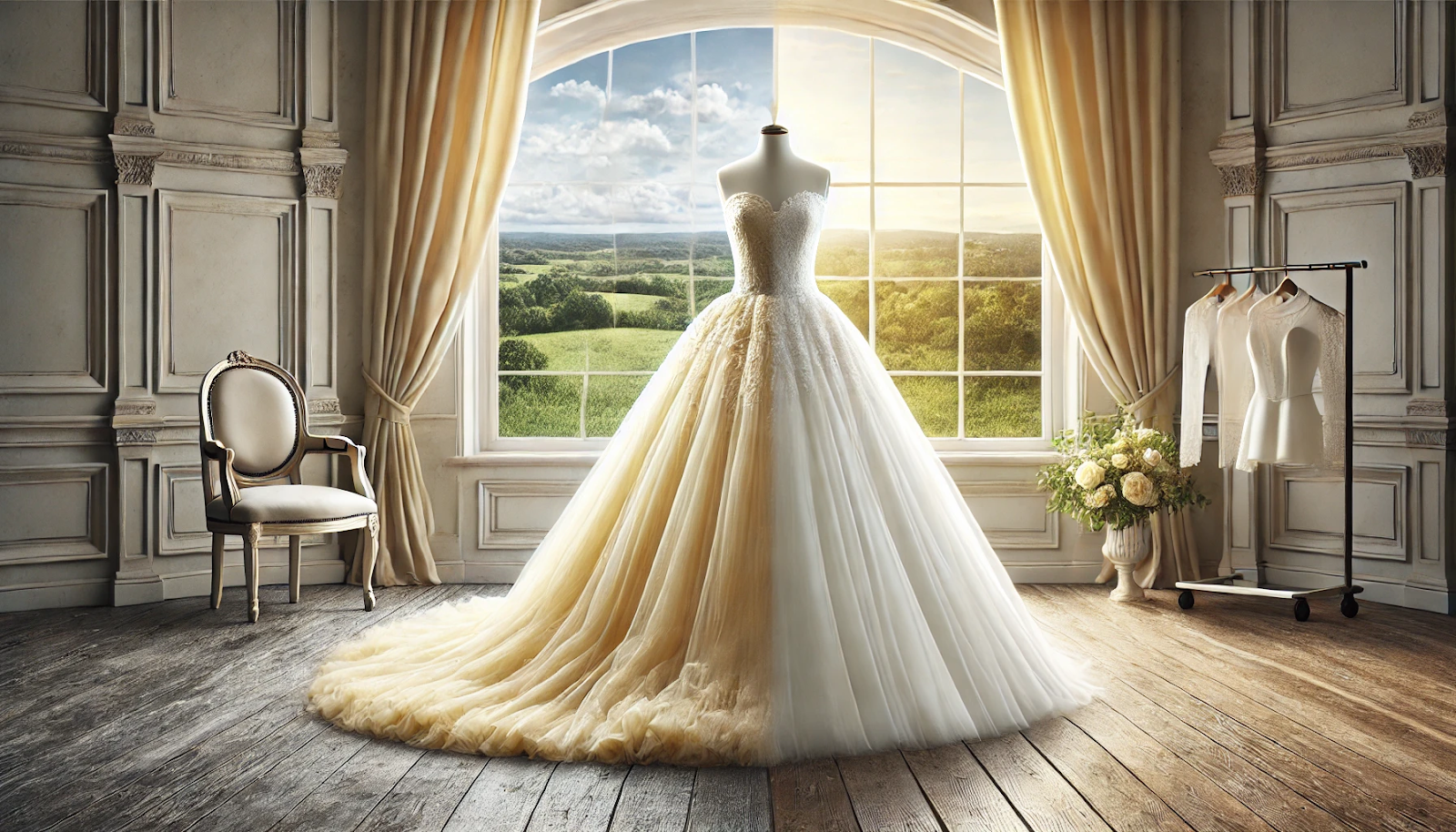Your wedding dress is a piece of LOVE STORY. Every time you see it, you get a glimpse of the HAPPIEST DAYS of your LIFE.
But what if you open your storage box only to find that your dress is yellowed, faded, and far from the pristine white it once was 😱? Scary. Right?
Finding that time has stolen its brilliance is no less than a disappointment.
"A wedding dress is the one outfit you want to stay perfect forever—but time has other plans.”
Yellowing is completely normal, and the good news is it's reversible.
Whether you want to pass it on to your loved ones, wear it on any occassion, or simply admire it without any stains, this guide can help you a lot.
Let's bring that YELLOWED wedding dress to LIFE and make it GLOW again - just like the day you said "I DO." ✨
Why Do Wedding Dresses Turn Yellow?🤔
If your wedding dress was in a storage box for years and now looks more ivory than yellow, don't panic. Here's what may have happened:
Fabric Breakdown

Wedding dresses are made with delicate fabrics, such as -
-
Lace
-
Silk
-
Tulle
These naturally age and weaken with time. This slow breakdown further leads to yellowing and discoloration.
Oxidation Exposure

Even if you have stored your dress well, exposure to light and oxidation can cause chemical reactions.
These can make the fabrics turn yellow over time. The process usually happens gradually, and it is almost unavoidable if you are not preserving it properly.
Invisible Stains

Some stains from perfume, makeup, sweat, or even champagne may not be visible at first. However, with time, they become brown or yellow. These stains usually appear years later.
Exposure to UV Light ☀️

Sunlight and other bright light sources contain ultraviolet (UV) rays. These can break down fabric fibers.
The longer a wedding dress is exposed to UV light, the faster it yellows.
Storing a dress in direct sunlight or under harsh artificial lighting speeds up oxidation. It causes the fabric to discolor more quickly.
That’s why museums take special precautions. They keep delicate fabrics out of direct sunlight and store them in UV-protected cases to prevent damage.
Improper Storage Conditions

How and where you store your dress can speed up the yellowing process. Common storage mistakes can include -
-
Plastic Garment Bags
These trap humidity, and result in oxidation.
-
Cupboard Boxes
The acids present in untreated cardboard can lead to discoloration.
-
Damp or Humid Environment
Moisture leads to mildew, mold, and fabric yellowing.
Use of Harsh Chemicals

If you are cleaning your dress using -
-
Harsh detergents,
-
Bleach, or
-
Dry-cleaning chemicals.
The residue can affect the fabrics with time. It leads to discoloration.
So, Why Do Your Wedding Dresses Fade to Yellow Over Time?
Yellowing fabric is one of the biggest challenges in the textile industry. Unfortunately for brides, white and pastel fabrics are the most vulnerable to this issue. And you cannot deny this fact.
The reason behind this fading is simple: fabric fibers start to break down chemically over time.
This natural process causes the once colorless chemicals within the fabric to turn light to medium yellow.

In older gowns, this aging can become more severe. It leads to dark brown or even black stains that were likely invisible when the dress was first stored.
One of the biggest culprits of yellowing? Plastic storage bags.
Many brides unknowingly store their dresses in plastic garment bags. However, these release harmful fumes that speed up discoloration.
Even with proper storage, some fabrics age faster than others. It becomes impossible to prevent yellowing completely.
Delicate materials like lace, silk, and sheer fabrics are especially fragile. Even something as mild as dish soap can damage them beyond repair.
So, harsh cleaning treatments should be avoided at all costs.
Yellowing isn’t a myth—it’s inevitable.
Natural fabrics deteriorate quickly when exposed to -
-
Sunlight,
-
Moisture, and
-
Heat.
Even if you take extra precautions, storing a dress in a plastic bag almost guarantees phenolic yellowing.
It is a chemical reaction between the plastic and the fabric that leads to discoloration.
Most modern wedding dresses are made using natural and synthetic fibers. It becomes even trickier to prevent yellowing.
It can be challenging if you try to restore a gown on your own. So, hiring professional wedding dress restoration services is highly recommended.
Specialists use advanced techniques to bring back the original color of yellow gowns without causing further damage.
Can You Hand-Wash a Yellowed Wedding Dress Without Ruining It?
It can be tricky to restore a yellowed wedding dress on your own. The reason is that different fabrics react differently to cleaning.
A simple DIY kit can bring back the original color, but there's always a risk of causing more damage than good.
If you're thinking about trying it yourself, keep these important tips in mind when cleaning a yellowed wedding dress:
1. Be Careful with Bleach ❌

Bleach might work for cleaning baseball pants. However, it can be a disaster for delicate fabrics like silk. Instead of removing stains, bleach -
-
Weakens fibers,
-
Damages embellishment, and
-
Leaves permanent marks on your gown.
2. Soaking Works Better Than Scrubbing 💦

Scrubbing can damage the delicate fibers of a wedding dress.
So, it is best to soak the dress in lukewarm water to help lift stains without causing fabric wear and tear.
Let the dress sit in water for a few minutes. It is a gentler approach to stain removal.
3. Know Your Fabric Type 👗

Silk dresses need special care. Harsh cleaners can ruin them, so it’s best to leave them to a professional.
Other fabrics (like polyester or lace) may handle stronger cleaning agents better.
If your dress has mild yellowing without dark brown or black stains, you can restore it yourself.
|
🚨 Warning: Stains such as -
These often seep deep into the fabric and require professional treatment. Surface stains (like makeup) are easier to handle at home. |
4. Be Cautious with Ironing 🥵

Ironing delicate fabrics can burn or melt them if the temperature is too high. If your dress has wrinkles:
✔️ Drop the idea of ironing
✔️ Try a steam bath: Hang the dress on a bathroom door. Now, turn on the hot water in the shower, and let steam loosen stubborn wrinkles. Do the same for about 30 minutes.
If you truly value your wedding dress, taking it to a professional cleaner is the safest option. But if you're set on doing it yourself, do it with caution! ✨
How Professionals Restore a Wedding Dress?
Can a yellowed wedding dress be restored? Yes, as no other type of clothing gets as much care and attention as a wedding dress when it comes to professional preservation.
Wedding dress cleaning specialists -
-
Remove stains,
-
Fix discoloration and
-
Restore your dress to its original beauty.
You get a completely new dress, just like when you first tried it on in the store.
🔎 Step 1: Fabric Identification

Experts first determine what fabric your dress is made of. The thing is, different materials require different cleaning methods.
If your gown is older and doesn’t have a fabric tag, in-house specialists can test the fabric. It is done to identify its exact composition.
🧵 Step 2: Checking Fabric Condition

Not only does the fabric type matter, but also its current condition. If your gown has delicate features like a French Bustle, you need to be extra careful. If you drag it over rough surfaces or shut it in a car door, it may weaken or damage the fabric.
🩸 Step 3: Look for Stains

Stains—especially deep ones—must be treated carefully. If a stain is too old or has started breaking down the fabric, harsh treatments can cause more damage.
Each stain is graded. So, if any serious issues are found, the experts will contact you to discuss possible solutions.
👗 Step 4: Whitening and Restoration

Professional methods can restore your original whiteness if your wedding dress has faded or turned yellow.
These advanced cleaning methods are safe and highly effective. You get a surety that the delicate fabrics don’t get damaged in the process.
💡 Final Steps: Cleaning, Pressing, and Storage
-
Your dress is gently cleaned.
-
The dirt, stains, and odors are removed.
-
It is then carefully pressed to remove any wrinkles.
Finally, it is placed in a beautiful preservation box of your choice. The dress becomes ready for storage or to be passed down to future generations.
Why Professional Cleaning is the Best Choice?
With a wedding dress preservation service, you ensure your gown is handled with expert care. They use the best techniques to:
✅ Remove stains without harming the fabric
✅ Treat fragile areas with unique solutions
✅ Restore color and brightness
✅ Provide long-term storage solutions to prevent future yellowing
Find a reputable wedding dress preservation service if you want to keep your dress in perfect condition. The results can be truly amazing.
This allows your gown to look just as stunning as the day you wore it! ✨👰
What Else You Need to Know?
Why does my wedding dress look yellow?
It can be due to the chemical breakdown of the fabric fibers or because you stored your wedding dress in a plastic bag.
Can you fix a yellow wedding dress?
Yes, you can hire professionals to fix a yellowed wedding dress. They use gentle yet safe cleaning methods to remove the yellowing and restore the dress to its original state.
How to whiten a yellowed dress?
There are a lot of methods you can use, like soaking, white vinegar, or more. However, nothing can beat the services that a professional provides.
Can you get yellowing out of a dress?
Yes, the use of warm water and oxygen-based bleach powder can get the yellowing out of a dress. However, you can consider hiring professionals for the best results.








